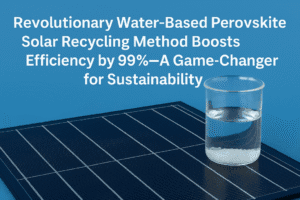Revolutionary Water-Based Perovskite Solar Recycling Method Boosts Efficiency by 99%—A Game-Changer for Sustainability!
Perovskite solar cells—praised for outperforming silicon in efficiency and cost—face a critical hurdle: toxic lead content that risks environmental harm. Researchers have now pioneered a water-based recycling technique using non-toxic ingredients like sodium acetate (found in vinegar) to dissolve lead, and sodium iodide to regenerate pure perovskite crystals. This method recovers 99% of materials, maintains near-original efficiency through multiple cycles, and eliminates hazardous solvents.
By closing the loop on lead reuse, it prevents soil contamination and reduces reliance on destructive mining practices. Unlike silicon panels, which often end up in landfills, perovskites reborn through this process could enable a circular economy where solar tech is endlessly renewed without waste. The innovation not only addresses perovskite’s Achilles’ heel but redefines sustainability in renewables, proving clean energy can be truly clean at every stage—from production to rebirth.

Revolutionary Water-Based Perovskite Solar Recycling Method Boosts Efficiency by 99%—A Game-Changer for Sustainability!
The solar energy industry has long grappled with a paradox: while renewable technologies promise a cleaner future, their production and disposal often carry hidden environmental costs. Traditional silicon panels, for instance, require energy-intensive manufacturing and pose recycling challenges, with millions of tons slated for landfills by 2050. Enter perovskite solar cells—a lightweight, efficient, and cheaper alternative. But their Achilles’ heel? Toxic lead content and unresolved recycling questions. Now, a groundbreaking water-based recycling method is turning this weakness into a strength, offering a blueprint for a truly circular solar economy.
The Perovskite Paradox: Efficiency vs. Toxicity
Perovskite solar cells have dazzled researchers with their potential to outperform silicon in efficiency and cost. Yet their reliance on lead—a neurotoxin—has cast a shadow over their eco-friendly claims. Discarded panels risk leaching lead into soil and water, creating a hazardous legacy. Previous recycling attempts relied on harsh solvents like dimethylformamide, which merely traded one environmental problem for another.
A Water-Based Solution: Simplicity Meets Innovation
A recent study unveils a surprisingly elegant fix: a non-toxic, water-based solvent that recovers 99% of a perovskite cell’s materials. The formula combines three affordable ingredients:
- Sodium acetate (found in vinegar) to neutralize and extract lead ions.
- Sodium iodide and hypophosphorous acid to rebuild pristine perovskite crystals.
This method sidesteps toxic solvents entirely, making recycling safer and scalable. Remarkably, cells reborn from this process retain nearly their original efficiency, even after multiple recycling cycles.
Why This Matters: Beyond Recycling
- Closing the Loop on Toxicity: By recapturing lead and reusing it, the method prevents environmental contamination while reducing demand for new lead mining—a process linked to pollution and health risks.
- Energy and Cost Savings: Perovskites already require less energy to produce than silicon. Pairing this with efficient recycling could slash the carbon footprint of solar tech.
- Circular Economy in Action: Unlike silicon panels, which often downcycle into lower-value materials, perovskites can be regenerated indefinitely without quality loss—a first for solar tech.
The Road Ahead: Scaling and Scrutiny
While promising, challenges remain. Scaling the process to industrial levels will require optimizing costs and energy use. Researchers also stress the need for comprehensive life cycle assessments (LCAs) to validate net environmental benefits. For instance, if recycling perovskite panels uses less energy than producing new ones, their advantage over silicon grows exponentially.
A New Dawn for Solar?
This innovation isn’t just about improving recycling—it’s about redefining sustainability in renewables. By addressing perovskite’s biggest liability, scientists have unlocked a path to commercial viability. Imagine a future where solar panels are leased, not sold, with manufacturers reclaiming materials to build new ones—a system that rewards durability and recyclability.
As the world races to decarbonize, such breakthroughs underscore a critical lesson: Truly clean energy must be sustainable at every stage, from lab to landfill (or rather, back to the lab). For perovskite solar cells, the future looks brighter—and greener—than ever.
You must be logged in to post a comment.